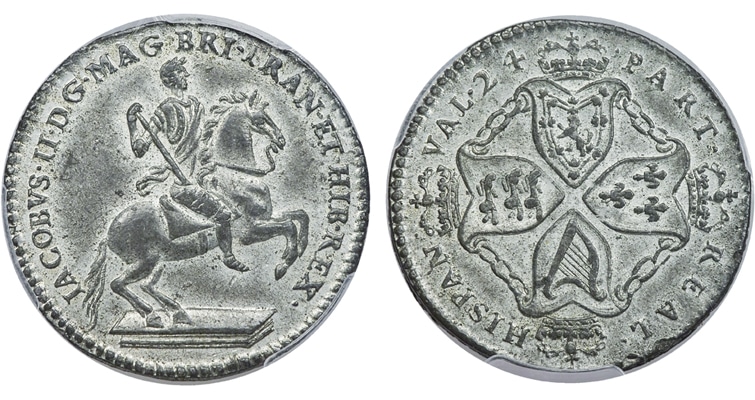Previously we discussed the situation of coinage in the American colonies and how a shortage of coins led to the creation of the Pinetree Shilling by the Boston Mint. Here was a coin that came about because of necessity but was never officially accepted by the authorities in Great Britain. Political chaos caused by the English Civil War and its aftermath stalled any action, however, and the Pinetree Shilling continued to be minted in Massachusetts until 1682, long after Charles II became king. It was a highly useful coin.
Another colonial coin had the opposite story: it was conceived of not as a practical tool, but as a way to help the tin mining industry. It had at least the pending sanction of King James II, but it was very likely never in circulation due to yet another overthrow of the English Crown. This was the American Plantation Token of 1688.
In the late 1670s, the English tin industry experienced a depression, and owners of tin mines in Cornwall and Devonshire had to come up with a new way to offload their now low-value product, so they persuaded royal authorities to purchase their tin and to mint coins with it. The result was the Charles II tin farthings and halfpence of 1684 and 1685. The 1685 coins are very rare because Charles II died in February of 1684, so not very many were minted after that.
Another reason that few of these farthings and halfpence have survived in good condition is that tin isn’t a good metal for coinage. It begins a slow transformation from white tin to gray tin when the temperature dips below 56 degrees Celsius. Watch this time-lapse video of tin disintegrating at -40 degrees Celcius/Fahrenheit to see what happens to tin in very cold temperatures.
In any case, since those same tin mine owners had found a way to make money again, they approached the crown again – this time James II’s royal authorities – to buy tin and mint a Plantation Token for use in the American colonies. In the summer of 1688 their agent, Richard Holt, applied for permission, hired engraver John Roettier to design the coin and cut dies, and requested the use of minting presses and tools. Some coins were struck, but, unfortunately, in November of 1688 William of Orange arrived in England and deposed his uncle/father-in-law in the Glorious Revolution. Coins with James II’s face on them – like the Plantation Token – were now decidedly de trop.
So did any of those minted Plantation Tokens make it into circulation in the New World? This is a modern coin mystery that has yet to be solved given that written records are unclear, they were minted in small numbers, and tin was a poor material for lasting coinage. The token was valued not in pence, but as 1/24th of a Spanish real. This was because in 1688 Spanish coins were much more common there, given that the mint in Mexico City had been in existence for over a hundred years since 1535.
Interestingly enough, there was a 1690 William and Mary tin farthing struck. You’ve got to give those Cornwall and Devonshire tin mine owners credit for persistence. They found a buyer for their product until 1692 when once again copper began being used.

